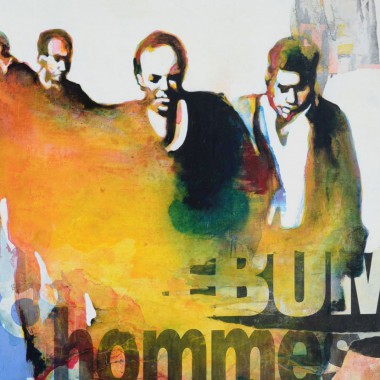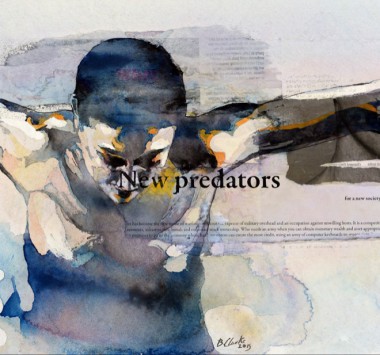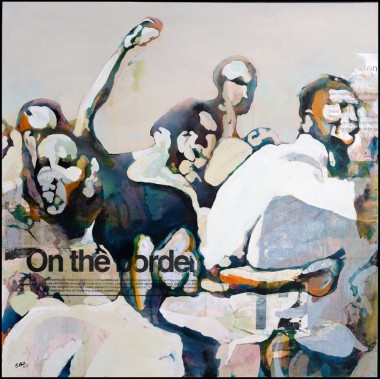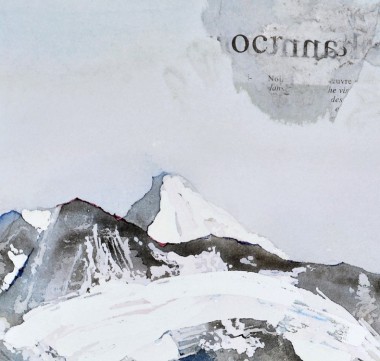About Bruce Clarke :
Visual artist and photographer, Bruce Clarke was born in London in 1959. It was at the Fine Arts School at Leeds University in the 1980’s that he was initiated to the Art and Language movement around Michael Baldwin, David Bainbridge, Terry Atkinson, Harold Hurrell. In the wake of these pioneering conceptual artists, Clarke’s work engages with contemporary history, the writing and transmission of this history and hopes to stimulate thought on the contemporary world and its representations. Deeply anchored in a school of critical figuration, his artistic research integrates codes finally to use them to criticize and demystify structures of power and injustice.
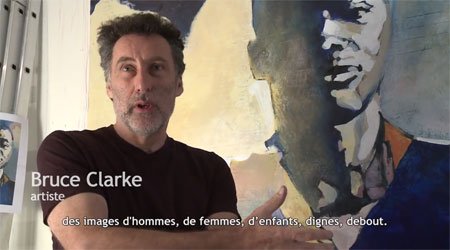
Bruce Clarke is a committed artist. An important figure in the anti-apartheid movement in France with the Rencontre Nationale Contre l’Apartheid, he became deeply involved in the mobilisation of the French public opinion against the South African apartheid regime on his arrival in Paris. In parallel he followed the evolution of the situation in Rwanda and the planned and proclaimed genocide, participating in the creation of a collective for solidarity with the Rwandese people. It was whilst doing a photo reportage in Rwanda for this collective in the days following the end of the genocide that he came face to face with the horrific reality. A few years later he started to work on the creation of a memorial site near Kigali, the Garden of Memory, a monumental installation project on-going since 2000, in close collaboration with survivors’ families, civil society associations and the Rwandese institutions as well as UNESCO. He later working on a large scale mural project for the 20 th commemoration of the genocide in Rwanda entitled Upright Men (www.uprightmen.org) in Rwanda and elsewhere in the world (Ouidah, Geneva, Lausanne, Brussels, Paris, Montreal etc…)
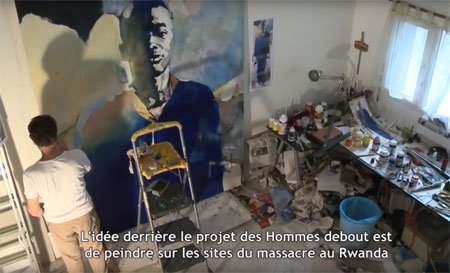
After two long trips to India in 2011 he began the project “People in the Crowd” in which he intends to evoke the power of the crowd as a force for change in the world.
As resident artist invited by the Conseil Général de Guadeloupe (French Caribbean), he produced an exhibition “Fragments of tomorrow’s History” relating the link between the slave trade, colonialism and globalisation. Collaborator in the Lille based Fest-Africa organisation’s project on Rwanda: Write, Film, Paint in memory, he has also worked with the Afrika Cultural Centre in Johannesburg and led visual arts workshops in South Africa, Ethiopia, Rwanda, Benin, Tanzania and France. In 2006 he published Dominations with Homnisphères publishing house.
As a photographer, he has published photo reports on South Africa, the reconstruction of Rwanda, the return of Liberian refugees and Palestine.
His work has been exhibited in Europe, in Africa and the United States.
An active commitment
"Our humanity demands that we give, even it be in the space of a brief instant, face, name, voice and living memory to the hundreds of thousands of victims so that they aren’t merely synonymous to numbers, or worse still, thrown into the depths of forgetfulness or at best left sleeping in a few tables of statistics more or less officially recognised by the consciousness, which we call collective."
(Abdourahman A. Waberi, Moisson de crânes, (Harvest of skulls) Texts for Rwanda, p. 17).
No artist is isolated from his socio-political environment. His or her activity as a visual artist is, in itself a commitment, a critical commentary on the world. For Bruce Clarke his artistic work is inseparable from his political activism, firstly in relation to South Africa where he played a role on the anti-apartheid movement in France and with the ANC (African National Congress). He continues working on cultural projects in this country, particularly with the Afrika Cultural Centre in Johannesburg.
In the early 1990 s, Bruce Clarke closely followed, with his exiled African friends in Paris, the evolution of the war in Rwanda and the first signs of the genocide before coming face to face with the horror in August 1994 when he travelled on behalf of a collective of associations with which he was working, protesting against the open preparation of genocide. Thus was born the first ideas for the “Garden of Memory” which was enthusiastically welcomed by the institutions and civil society associations in Rwanda and which goes well beyond a simple artistic production. It is a project in progress close to Kigali.
"At that point, I began to reflect on the period after genocide. What role can an artist play in the preservation of real, living memory? Can he contribute to the psychological reconstruction of a totally traumatised population? With this project we had to make the reality of genocide tangible. What was left after the genocide, what we could see, wasn’t human anymore. It was a sort of abstraction: bones, mummified bodies. But these people had really existed; they had been people like you and me, who had a life behind them, a life now completely annihilated."
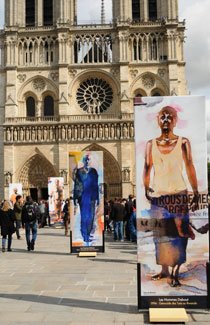
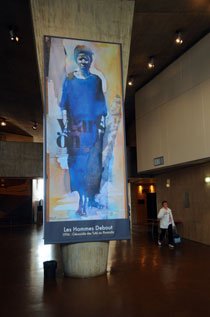
Notre Dame - ParisUNESCO - Paris
"That was the beginning of my reflection. Genocide had taken place in Rwanda. Approximately one million people had been killed. But each person killed had been an individual, with a face, occupying space. Wole Soyinka, the Nigerian writer has said that when a person is killed, it’s a tragedy, but when a thousand people are killed, it’s only a statistic. That’s what had to be avoided at all costs. It was fundamental to give back faces and individuality to the victims of tragedies, such as those in Rwanda, Palestine or elsewhere in the world. So the project, the Garden of Memory came out of a reflection on the way in which an artist can intervene in a very real situation. I had two principal preoccupations at the beginning of the project: How to take into account the enormity of what a genocide is – up to a million people killed. And at the same time it was essential to give a sense of humanity to each victim."
"As a foreign artist, I didn’t feel that I had the right to work with such sensitive material as human remains. I didn’t want to deal with it from that point of view, for obvious reasons. Distance had to be maintained. But how do you take distance as an artist? I thought that the distance could be found through inanimate matter – stone – which is abstract and at the same time full of symbolic meaning. That’s how I decided that the basic material for the Garden of Memory would be stone. But the garden wasn’t destined to be a place evoking horror; it had to be a place of contemplation. Where people could come and stroll. A garden is a place of renaissance; it isn’t a cemetery, or a place of death, even if it’s very pregnant with meaning. Besides this, the realisation of the project had to be done in strict collaboration with Rwandese civil society: the survivors, the women’s associations…"
"The Garden of Memory is a collective work. Even if the conception is mine, the project wouldn’t have any meaning if there wasn’t large scale participation in its realisation, or if the people involved didn’t fully understand the project and adhere to its ideas."
"The basic concept is very simple: it’s an individual act of memory in remembrance of an individual victim. This individual act is accomplished by a relative or close friend of the victim. The individual act is the posing of a stone with a mark on it. The person who puts the mark on the stone isn’t obliged to explain the mark to anyone. The mark can be a name or something abstract, but it must be an inscription in memory of a victim. Such an individual act of memory could be seen as a cathartic process opening the moment of mourning. So it’s this individual act of memory that we want "quite simply" to multiply by a million; make up a collective work composed of a million stones, each one being individualised and posed by someone close to the victim of the genocide. Posed according to a geometric schema that will evolve with time."
The Garden of Memory was first inaugurated on the 5th June 2000 in an important cultural manifestation, Fest’Africa in Rwanda. It is an on-going project.
How can art influence or comment on the course of history?
This is the principal and basic question that the Bruce Clarke, as a visual artist is asking himself through his life and work.
Text : Michèle Baj-Strobel
Solo exhibitions (selection)
2019 Fantômes de la Mer, Alliance française Johannesbourg
2019 Predators and Other Friends, Galerie Art-Z, Paris
2019 Lifting the Veil, Théâtre royal de Marrakech, Maroc
2018 Birth of an Icon, Kloser Contemporary Art, Anvers, Belgique
2018 Front Line, Espace Anis Gras, Arcueil
2018 Alliance française de Lusaka, Zambie
2017 Fantômes de la Mer, ARTCO Gallery, Aix-la Chapelle, Allemagne
2017 New Horizons, Cloître des Billettes, Paris,
2017 Mémoires vives et Hommes debout, Musée de Coutances, France
2016 Sea Ghosts, French Institue, Nouakchott, Mauritania
2015 Daily Violence, Multimedia centre Lormont, France
2014 Humanities Gallery Out of Africa, Sitges, Barcelona, Spain
2014 En toute impunité, Gallery Les Naufragés du Temps, St Malo, France
2014 Upright Men, Simultaneous exhibitions (Geneva, Lausanne, Paris, Brussels, Luxemburg, Kigali, Limoges, Liège…) for the 20 th commemoration of genocide in Rwanda
2013 Precarious Lives Gallery Julio Gonzalez, Arceuil, France
2013 Janus Gallery, Montreux, Switzerland
2013 M.I.A. Gallery Seattle, United States
2013 Body and Souls, Grenoble, France, Maison de l’International
2012 Artium Gallery, Luxemburg
2012 Fondation Zinsou, Benin
2011 Who’s Afraid , Musée des Arts Derniers, Paris
2010 Neumünster Abby, Luxemburg
2010 Artium Gallery, Luxemburg
2010 Bekris Gallery, San Francisco, United States
2010 Musée des Arts Derniers, Paris, France
2009 Geneva Book Fair, Switzerland
2007 Other(s), l’Art et la Paix Gallery, France
2006 Musée des Arts Derniers, Paris, France
2006 Arcima Gallery, Paris, France
2006 Troubled identity, mixed identity, Plein Sud Festival, Cozes, France
2005 Arrêt sur Image Gallery, Bordeaux, France
2004 I’m writing to you from the Garden of memory - installation, Dak’Art off, St Louis, Senegal
2004 Les Naufragés du Temps Gallery, St Malo, France
2002 Union des Arts Plastiques, Guest artist, St-Etienne- du-Rouvray, France 2002 Fragments of tomorrow’s History, L’Artchipel, Basse-Terre, Guadeloupe 2001 Centre Rémy Nainsouta, Guadeloupe, French Caribbean.
2000 I’m writing to you from the Garden of memory - Installation, Gallery Porte 2a, Bordeaux, France
2000 Château de St-Ouen, Saint-Ouen, France
1999 French Cultural Centre, Kigali, Rwanda
1999 Fragments of History, Grenoble International, Grenoble, France
1997 Rayon Vert Gallery, Nantes, France
1997 South African Embassy, Paris, France
1997 Museum of Romans, Romans, France
1996 Marina Gallery, Avignon, France
Group exhibitions (selection)
2019 Urban Art Fair, Paris
2018 Art Paris 2018, Grand Palais Paris
2018 Fusions, Bordeaux, avec Migrations Culturelles 2a (MC2a)
2017 Galerie Vallois, (avec l'artiste Aston) Paris,
2017 AKAA Art Fair, Paris
2016 Tribute to Dak’Art, Martigny, Switzerland
2016 Sea Ghosts, Subabiennale, Dak’Art Off, Senegal
2016 Targets, ArtCo Gallery, Aachen, Germany
2016 Cape Town Art Fair, Le Cap Johannesburg
2015 Africa/Africains, Museu Afrrobresil, Sao Paolo, Brazil
2015 Global Topics, ArtCo Gallery, Aachen, Germany
2014 FNB Art Fair, Johannesburg
2013 Etonnants Voyageurs Festival, Saint-Malo, France
2012 Iwalewa Haus – Bayreuth, Germany
2012 Boxe Boxe, Fondation Blachère – Apt, France
2010 Couleur Café Festival, Bruxelles, Belgium
2009 Africajarc Festival, Carjac, France
2008 Musée des Arts Derniers, Paris, France
2008 Contemporary Art Fair, Espace Pierre Bergé, Bruxelles, Belgium
2007 East African Biennale, Dar es Salam, Tanzania
2004-5 La Galerie.be, Bruxelles, Belgium
2004-5 Musée des Arts Derniers, Paris, France
2004 Ephémère Gallery, Montigny-le- Tilleul, Belgium
2003 L’Essor Gallery, Le Sentier, Switzerland
2002 Dak’art Biennale, Dakar Senegal
2001 Belfort Art and History Museum - with Edith Convert, Belfort, France
2001 The Artist and the Real, Maison de la Culture de la Nièvre, Nevers, France 1998 Kulturfabrik, Luxembourg
1995 Africanités, Saintonge Gallery, Paris, France
1995 art’CRA, Accra, Ghana
1994 De l’Afrique à l’Afrique, Gallery Yahia, Tunis, Tunisia
Public collections
- Zinsou Foundation, Cotonou, Benin
- Contemporary Art Museum, Ouidah, Benin
- Blachère Foundation, France
- Tilder Foundation, France
- Artocarpe, Guadeloupe contemporary art museum, France
- Cities of Paris, Bordeaux, Bègles, France
- Museum for Palestine, UNESCO, Paris
Press kit
































